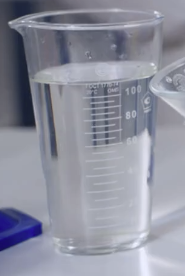| "Descrizione" by AColumn (9402 pt) | 2023-Jun-16 23:28 |
Review Consensus: 7 Rating: 7 Number of users: 1
| Evaluation | N. Experts | Evaluation | N. Experts |
|---|---|---|---|
| 1 | 6 | ||
| 2 | 7 | ||
| 3 | 8 | ||
| 4 | 9 | ||
| 5 | 10 |
Isopropyl myristate is a chemical compound obtained from the esterification of myristic acid and isopropyl alcohol, an ester resulting from the reaction of isopropyl alcohol with myristic acid.
It appears as a colourless liquid.

The synthesis process takes place in different steps:
- Esterification. Isopropyl alcohol (also known as isopropanol) and myristic acid undergo an esterification reaction. The reaction typically takes place in the presence of an acid catalyst, such as sulphuric acid or p-toluenesulphonic acid. The esterification process involves the condensation of the hydroxyl group (-OH) of the isopropyl alcohol with the carboxyl group (-COOH) of the myristic acid, resulting in the formation of Isopropyl myristate and water.
- Purification. Crude Isopropyl myristate obtained from the esterification reaction undergoes purification processes to remove impurities, unreacted starting materials and water. Purification techniques may include distillation, solvent extraction or chromatography.
- Filtration and drying. After purification, Isopropyl myristate is filtered to remove any solid particles or undissolved impurities. The filtered solution is then dried to remove residual moisture, resulting in the final product Isopropyl myristate.
The synthesis process may involve further steps and variations depending on the specific production process and quality requirements. It is important to note that the production of Isopropyl myristate is typically carried out in industrial environments by specialised manufacturers.
What it is used for and where
Isopropyl myristate has many applications in the food, cosmetics and pharmaceutical industries as an emollient, thickening agent or lubricant.
Cosmetics
Skin conditioning agent - Emollient. Emollients have the characteristic of enhancing the skin barrier through a source of exogenous lipids that adhere to the skin, improving barrier properties by filling gaps in intercorneocyte clusters to improve hydration while protecting against inflammation. In practice, they have the ability to create a barrier that prevents transepidermal water loss. Emollients are described as degreasing or refreshing additives that improve the lipid content of the upper layers of the skin by preventing degreasing and drying of the skin. The problem with emollients is that many have a strong lipophilic character and are identified as occlusive ingredients; they are oily and fatty materials that remain on the skin surface and reduce transepidermal water loss. In cosmetics, emollients and moisturisers are often considered synonymous with humectants and occlusives.
Binder. A binding compound that is used in cosmetic, food and pharmaceutical products as an anti-caking agent with the function of making the product in which it is incorporated silky, compact and homogenous. The binder, either natural such as mucilage, gums and starches or chemical, may be in the form of a powder or liquid.
Fragrance. It plays a very important role in the formulation of cosmetic products as it allows perfume to be enhanced, masked or added to the final product, improving its commercial viability. The consumer always expects to find a pleasant scent in a cosmetic product.
Perfuming. Unlike fragrance, which can also contain slightly less pleasant or characteristic odours, the term perfume indicates only very pleasant fragrances. Used for perfumes and aromatic raw materials.
Medical
It is a penetration enhancer commonly used in topical and transdermal drug delivery formulations.

- Molecular Formula C17H34O2
- Molecular Weight 270.45 g/mol
- CAS 110-27-0
- UNII 0RE8K4LNJS
- EC number 203-751-4
Synonyms:
- Myristic acid isopropyl ester
- Isopropyl tetradecanoate
- 1-Methylethyl tetradecanoate
- Tetradecanoic acid, isopropyl
- isopropylmyristate
- Myristic acid, isopropyl ester
References_______________________________________________________________
Rajeshkumar N. Vadgama, Annamma A. Odaneth and Arvind M. Lali Green synthesis of isopropyl myristate in novel single phase medium Part I: Batch optimization studies Biotechnol Rep (Amst). 2015 Dec; 8: 133–137. Published online 2015 Oct 24. doi: 10.1016/j.btre.2015.10.006
Chunyi Zhao, Peng Quan, Chao Liu, Qiaoyun Li, and Liang Fang Effect of isopropyl myristate on the viscoelasticity and drug release of a drug-in-adhesive transdermal patch containing blonanserin Acta Pharm Sin B. 2016 Nov; 6(6): 623–628. doi: 10.1016/j.apsb.2016.05.012
| Evaluate |
